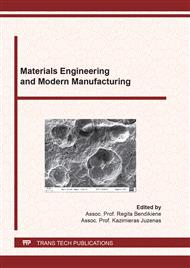p.144
p.150
p.155
p.161
p.169
p.176
p.181
p.186
p.193
Heat Conductive Plates from Recycled Niobium Slag
Abstract:
Niobium slag as a waste product from metallurgical production of metallic niobium, containing calcium aluminates mainly, is valuable raw materials for different new products in the building materials industry. Disintegrator milling technology for pretreatment of Nb-slag was used, consisting of following steps: a) precrushing of slag, b) separative milling for extraction of metallic Nb. The yield of metallic Nb with a purity of 90 – 95 % was about 1.0 %; mineral ballast consists mainly (about 98 %) from calcium aluminates. The potential application areas of fine fraction (less 0.3 mm) of calcium aluminates were studied a) as a component in concrete and ceramics and b) as the main component of heat conductive material. The technology, mechanical and thermal properties (strength, thermal conductivity and expansion) of materials were studied. As reference material analogous CPA commercial thermal plates (Cebud, Poland) were studied. In the result of studies of mechanical and thermal properties of calcium aluminate based materials, it was demonstrated that the application of them as heat conductive material is more prospective.
Info:
Periodical:
Pages:
169-175
Citation:
Online since:
June 2021
Authors:
Price:
Сopyright:
© 2021 Trans Tech Publications Ltd. All Rights Reserved
Share:
Citation:


